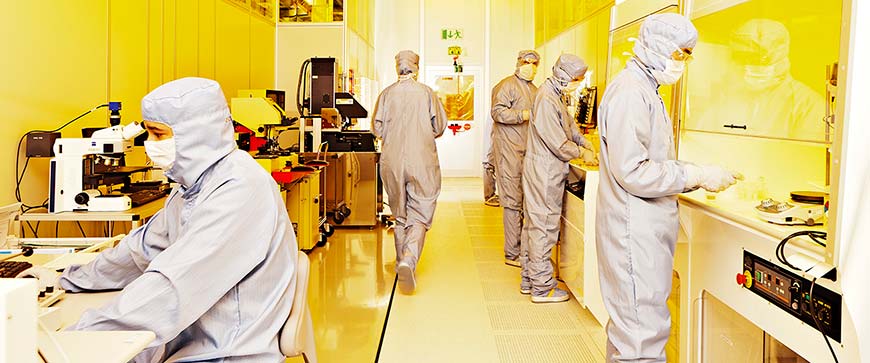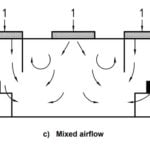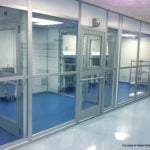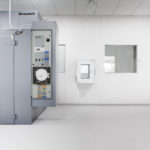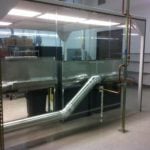Table of Contents
This post addresses air change tables and calculations in ISO 2, ISO 3, ISO 4, and ISO 5 cleanrooms with unidirectional airflow. In an earlier post on air change rates for cleanrooms, we outlined how to calculate cleanroom air exchange rates for ISO 6, ISO 7, and ISO 8 cleanrooms.
Within you’ll find summarized approaches for determining cleanroom air change rates, but not recommendations for your specific cleanroom. The final cleanliness of a cleanroom requires further consideration for the application and task at hand. Particle generation, deposition rates, sensitivity, heat load, and organizational choices also factor into the final airflow conditions.
What Cleanrooms Require Unidirectional Airflow?
Microelectronics cleanrooms require more stringent particulate controls than most cleanroom environments. Micro, or even nano-components, instruments, and thin films are more sensitive to particulates and operator interaction, thus scrubbing airborne contamination requires increased air exchange rates and laminar flow air.
The NTNU NanoLab featured above (CC: Geir Mogen/NTNU) shows a cleanroom designed for ISO-5 zones and equipped for nano-imprinting, dry etching, high resolution lithography, and thermal processes. Bio-nanotechnology includes both chemical and physical manipulations, which require extremely clean air and integrated workstations such as laminar airflow workstations.
Common ISO Class 5 (or cleaner) processes include but are not limited to:
- Photolithography
- Microprocessor fabrication
- Satellite optics and communication instruments
- Nanofilms, etching, layering
- Thin-film deposition
- Nanofabricated circuits
- Ion-milling
What Are the Advantages of Unidirectional Airflow Cleanrooms?
Unidirectional cleanrooms maintain extraordinary air change volumes which sweep away particulates during the production of optics, nanotechnology, and hyper-sensitive electronics. Contrarily, less intensive facilities with ISO 6 – 8 cleanrooms usually find non-unidirectional or mixed airflow systems most practical.
Unidirectional airflow and flowthrough air passage are most common in cleanrooms where the air is already of high quality and particulate generation is minimal. Proper calculation of the air exchange requirements favors performance factors including:
A) Achieve the correct particle concentration in the cleanroom during operation
B) Control the heat gains in the cleanroom
C) Compensate for room air leakage and process air exhaust
D) Provide proper air exchange for validation and scrubbing of particles
Unidirectional Air Flow Advantages
- Air exchange happens in a single motion without mixing dirty and clean all
- Reduces eddies, stale air, and air velocity variances
- Air velocity is uniform from the floor to the ceiling
- Exchanges air more efficiently with less pressure differential
Cleanroom designers must optimize air flow velocity and air exchange rates throughout a cleanroom, sometimes over many individual partitions and bays. A cascading pressure differential ensures the cleanest and highest pressure air (ISO 5 or cleaner) is reserved for the most critical operations. The ideal system reduces air supply in less critical spaces such as gowning and common areas (ISO 6-8), therefore improving overall energy efficiency.
Definition of Unidirectional Airflow for ISO Cleanrooms
ISO Class 5 (Class 100) or cleaner requires intensive air inputs, thus a unidirectional system is not only efficient and effective at introducing air, but also removing and refiltering the air without stirring or mixing clean and dirty air.
By definition under ISO 146144-4, unidirectional air flows through the entire cross-section of a clean zone with a steady velocity in approximately parallel streamlines.
Unidirectional Air Flow Rate Requirements
Unidirectional airflow patterns carry horizontally or vertically across space in parallel movement, usually between 60 – 90 FPM, give or take 20%. Airflow remains within 18 degrees of parallel with sufficient velocity to sweep away particles before affixing to surfaces.
The suggested air flow rates target particles of 5.0 µm or greater. Over past decades, Fed. Standards (now outdated) adopted these recommendations, later followed by concurrent standards of the International Standards Organization (ISO) and FDA.
The correct air supply rate is one of the most crucial factors in determining final cleanliness and efficiency. Below are two examples of unidirectional airflow, one flowing vertically and the other horizontally.
In many cases, ceilings require 100% coverage with fan filter units. A blower motor is integrated with a fan filter and affixed to a sealed ceiling grid and plenum. Some conditions require air that flows from the floor toward the ceiling, particularly when heat-intensive processes require cooling.
“For wider rooms (>16ft), it is best to provide raised floor return so that the airflow tends to remain parallel (or within 180 degrees of parallel). Where the clean space is fairly narrow, of the order of 14 to 16 ft (4.2 to 4.8 m) from wall to wall, the raised floor can be eliminated in favor of low sidewall return grilles. The air will move vertically downward to within 2 to 3 ft (0.6 to 0.9 m) of the floor before splitting and moving toward the sidewall returns.” CED Engineering
The above quote demonstrates how the floor plan and geometry influence the rooms final performance characteristics and vice versa.
How do I Choose the Correct Cleanroom Air Change Calculation Method?
During preliminary engineering, cleanroom designers must establish the required classification, in this case, we’ll reference ISO standards for particulate control.
It’s important to understand that the proper cleanroom classification is not only a measure of particle quantity but also size and characterization.
Our friends at PortaFab explain:
Determining Air Change Methodologies
After considering ISO classification with respect to the most problematic particles, cleanroom designers then deploy the most appropriate methodology for calculating air change rates based on the environment at hand.
- In unidirectional airflow cleanrooms, calculate air change rates with average airflow velocity.
- In non-unidirectional and mixed flow cleanrooms (usually ISO 6 – 8), use the air changes per hour (ACH) calculation method.
- Average Airflow Velocity (Read below)
- Air Changes Per Hour (ACH)
- Percentage of fan filter unit coverage
If the airflow in a cleanroom is non-uniform (non-unidirectional airflow), air velocity readings will not provide an accurate sample of inferential data points. Turbulence, eddies, processes equipment, and pressure differentials all influence velocity readings as exiting and returning air interact throughout the cleanroom. Data points would not represent a normal distribution of the actual room conditions. Non-unidirectional air patterns measured with average velocity readings often produce confusing, misleading, or extraneous data.
ISO standards outline unique air change calculation methods for unidirectional vs non-unidirectional cleanrooms.
| Cleanroom Class | Airflow Type |
| ISO Class 1 – 2 | Unidirectional |
| ISO Class 3 | Unidirectional |
| ISO Class 4 | Unidirectional |
| ISO Class 5 | Unidirectional |
| ISO Class 6 | Non-unidirectional |
| ISO Class 7 | Non-unidirectional |
| ISO Class 8 | Non-unidirectional |
ISO 5 Air Velocity Charts and Benchmarks for Cleanrooms
Unidirectional Air Change Requirements
Unidirectional air supply requirements in a cleanroom are suggested by average airflow velocity sampling. ISO 146144-4 suggests the airflow velocities below as follows:
| Velocity Threshold | ISO 5 | ISO 4 | ISO 3 | ISO 1-2 |
| Low-End Velocity (Meters/Second) | 0.2 | 0.3 | 0.3 | 0.3 |
| High-End Velocity (Meters/Second) | 0.5 | 0.5 | 0.5 | 0.5 |
View: Cleanroom Air Change Rates and Tables for USP Standards
Contrasting Air Change Rate Standards, Classification, and Unique Applications
The airflow principles herein are not mutually exclusive to a specific cleanroom classification.
Some cleanroom environments, such as compounding cleanrooms for sterile and hazardous drugs, require ISO 5 air with laminar airflow, but are not designed in full with unidirectional airflow principles. Work is only carried out within an isolated ISO 5 processing area, such as a biological safety cabinet or laminar flow hood. These systems benefit from the principles of unidirectional air flow, but do not require such aggressive measures against ultra-fine particulates. For info on air change rates and cleanroom design for biopharmaceuticals view our guide to USP cleanroom design.
Air Velocity Measurement Tools (Anemometers)
Calculating Volumetric Airflow
At the supply vents or fan filters, the volumetric flow should be checked by using the following formula:
Q = V x A
“V” is the average or center air velocity “A” is the area of the vent or fan filter. To determine the total volumetric flow for the room the procedure should be repeated at each vent or fan filter and then summed.
Cleanroom Anemometer Requirements
One example of cleanroom air velocity measurement standards are found in the procedural standards for certified testing of cleanrooms via the NEBB.
A reasonable specification for a digital cleanroom anemometer often falls within the following performance criteria:
Range: 0.25 – 12.5 m/s (50 – 2500 fpm)
Accuracy: ±5% of reading 0.50 m/s (100 fpm) or greater
Accuracy: ±10% of reading 0.50 m/s (100 fpm) or less
Resolution: 0.005 m/s (1.0 fpm)
Introductory anemometers range between $100 – $500. Base models models provide basic measurements, but have limited flow rates and data logging features. Commercial anemometers are available for ~$1,000, an essential tool for facilities and maintenance personnel when monitoring air exchange or troubleshooting ventilation systems.
Anemometer sensors must provide a wide dynamic range and accurate sampling data. High-quality anemometers feature unique attachments for variable test conditions including high & low-velocity measurements, onmi-directional probes, or simultaneous measurements of air temp, humidity, and flow rate.
Cleanroom anemometers cost between $1500 – $1800 and meet far more sensitive requirements and flow rates under turbulent or laminar flow conditions (as opposed to standard HVAC anemometers). Detachable probes and additional sensors for pressure differentials, temperature, and humidity offer valuable insights when addressing contamination or troubleshooting cleanroom HVAC issues. If you have more than one anemometer, detachable probes allow you to share the main unit or the probes.
- When the direction of the airflow is known, choose a UNIdirectional probe.
- When the direction of the airflow is unknown or turbulent, choose an OMNIdirectional probe.
For critical tasks, anemometer accuracy and sensitivity is crucial, as is well-designed software, stable battery life, and user-friendly features. When monitoring multiple locations or large databases, it’s important that the user be able to quickly log, categorize, and revisit unique data sets.
Climomaster™ Standard Hotwire Anemometer with Analog Output
- Differential Pressure available as an option
- Gives automatic flow rate readings by registering duct sizes (up to 25 duct sizes).
- Store the data or upload it to your PC via RS232C cable and software (both optional)
- 10 to 1000fpm (0.05 to 5.00m/s)
- Velocity: +/-2% of reading or +/-3fpm (+/-0.015m/s) whichever is greater
Extending Understanding: Demonstrating Unidirectional Airflow in Biological Systems
We can illustrate the differences in directional and non-directional air flow systems by contrasting the respiratory systems of birds and mammals.
Avian Respiratory Systems Mirror Unidirectional Cleanrooms
In birds, air flows in and out of the lungs only in a one-directional path. This allows birds to inhale and exhale in a single closed loop. C02 and oxygen exchange faster with less pressure variation and easily acclimate at higher elevations. No residual air remains in the lungs during the ventilation cycle, therefore achieving a more efficient rate of gas exchange than mammals.
Mammalian Respiratory Systems Mirror Non-directional or Mixed (Bi-directional) Cleanroom Airflow Designs
Humans, however, have bidirectional respiratory systems in which air must stop at an oxygen/C02 exchange point before making its way back out on exhale. Air moves in one motion toward the sacs in the lower diaphragm, and the opposite direction during exhale. The old air must mix with new air, therefore resulting in air with lower levels of oxygen.

“Most importantly, a bird replaces nearly all the air in its lungs with each breath. No residual air is left in the lungs during the ventilation cycle of birds, as it is in mammals. By transferring more air and air higher in oxygen content during each breath, birds achieve a more efficient rate of gas exchange than do mammals…The air-sac system is an inconspicuous, but integral, part of the avian respiratory system…Air sacs are thin-walled (only one or two cell layers thick) structures that extend into the body cavity and into the wing and leg bones…The air sacs make possible the continuous, unidirectional, efficient flow of air through the lungs.”
(Gill 2007:143-147)
The most efficient man-made systems often take design cues from biological systems. Cleanrooms are complex, as are the evolving systems found in nature. The most efficient systems — are regularly the most simplified designs of complex mechanisms.
Conclusions
In unidirectional airflow cleanrooms, calculate air change with average airflow velocity sampling.
Summarized:
- Benchmark for ISO 2 – ISO 5 facilities
- Airflow velocity is independent of the ceiling height
- Uniform velocity throughout the entire space
- Air flows through the entire cross-section of a clean zone
- Steady velocity and approximately parallel streamlines of 60 – 90 FPM
- Directional air flow can be attained both vertically and horizontally
The fundamental goal of each cleanroom is unique to its process, and so is the science behind its design. For most facilities, speaking with a controlled environment specialist is the fastest path from clean idea to a clean build.
The methods herein do not replace the expertise of experienced cleanroom designers and engineering teams. Instead, they may help you outline preliminary air requirements during the initial planning and organization of a cleanroom build.
Have questions? Get in touch with our controlled environment specialists.
Cleanroom Solutions
Keep Reading
Related Posts
-
The Truth about Cleanroom Air Change Rates, Charts & Methods of Calculation
Why Can't Anyone Agree on Benchmarks for Cleanroom Air Change Rates? There are a number of best practice guides and benchmarks for cleanroom air change rates (ACR). Many of which reference charts dating back as…
-
Cleanroom Components — Air Filtration, Design, and Other Variables
What are the key determinants of cleanroom components? Learn about different types of cleanroom filtration, wall construction, lights, temperature, humidity and more.
-
Cleanroom Fan Filter Units vs Air Handling Units
A cleanroom air handling unit (AHU) is a cornerstone of temperature, humidity, and pressurization within controlled environments. Today, modular fan filter units allow more adaptable configuration with simplified maintenance procedure. Both systems serve conditioned and…
-
Cleanroom Construction FAQ
Definitive Cleanroom Construction FAQ: How much does a cleanroom cost? How does the level of ISO classification impact build and operating costs? How much supporting space will I need for a cleanroom addition or ISO…
-
CleanPro® Softwall Cleanroom Enclosure
This customer needed to enclose a piece of machinery, and CleanPro® was able to provide a solution.
-
FS209E and ISO Cleanroom Standards
Before global cleanroom classifications and standards were adopted by the International Standards Organization (ISO), the U.S. General Service Administration's standards (known as FS209E) were applied virtually worldwide. However, as the need for international standards grew,…

